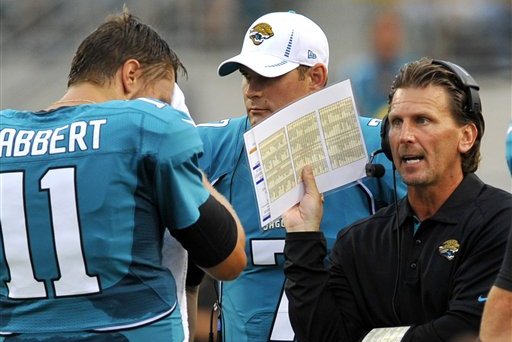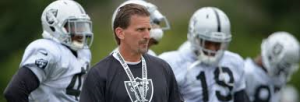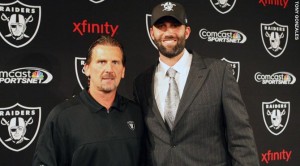When the name Greg Olson is mentioned in Duval County, there’s suddenly a sense of cautious optimism in the air. Jaguars fans are eager to welcome in a new era of football with Olson guiding the way for Blake Bortles, and yet we’re reluctant to cast away our doubts related to losing. After all, “Oley” has been around more than his fair share of losing teams as a quarterbacks coach or offensive coordinator, and last year his offense was, in a word, abysmal.
Is this really the man to turn the ship around and start scoring the kind of points necessary to contend? That’s hard to say considering his history as a coordinator wherein his teams were often near the bottom in points scored with seasonal averages in points-per-game ranging from 15 to 23. Aside from one stellar season in 2010 when the Bucs offense came to life, you have to look all the way back to his first full season as a coordinator with the Rams in 2006 to find legitimate offensive success on his resume.
So why did Gus Bradley hire the man? It’s not like Olson was the last man standing for the position. The Jaguars interviewed several top names, even hiring one candidate, former Bills head coach Doug Marrone, to be their OL Coach. Simply put, Gus and Greg clicked in their interview. Soon after the hire Coach Bradley explained, “I’ve known ‘Oley … I know what we have in the room, what we’re looking for, and I just felt like he was the best fit.”
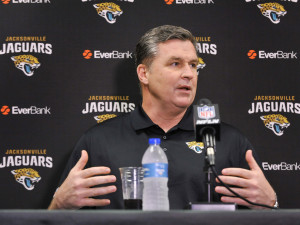
When Oley’s lackluster stats as coordinator were brought up, Gus explained, “We don’t get caught up in traditional numbers like that. We’re looking at does the team get better and does the talent he has progress? Just my conversations with him … I think we’re really close in mind in the vision we have.”
Gus then added, “You want to make sure he can easily adjust based on who we have as far as personnel, and again, I go back to the developmental part: he’s had a history of developing quarterbacks.”
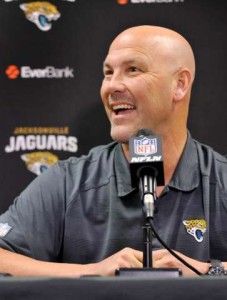
There are plenty of reasons to embrace the man as our new OC, and this touches on a couple of them. Easily overlooked in the stats is that Olson hasn’t exactly had much in the way of elite talent to work with since coaching Drew Brees into a two-time Heisman finalist with Purdue in the late nineties. He has, however, coached up a few average-level talents into starters, and this is of particular interest to Jaguars fans who, by-and-large, see something special in Blake Bortles. Greg Olson’s story as a football coach, beyond the stats, helps give some perspective on the man.
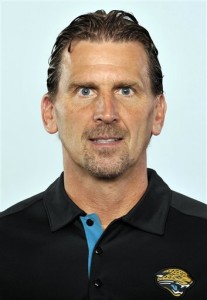
In college, Olson was primarily a QB coach (he began as a RB coach in ’86 for Spokane Falls Community College) having coached Jon Kitna at one point prior to Brees. He started out in the NFL as a QB coach with the 49ers in 2001 helping Jeff Garcia reach his second Pro Bowl after a 12-4 season as Tim Rattay warmed the bench behind him. In his third NFL season, Garcia posted a career-best 32 TDs along with 12 INTs and a QB rating over 100 in half his games. In the New Orleans Superdome for the season finale, Garcia put up a near-perfect 149.3 QB rating (perfect is 158.3) winning a 4-TD game 38-0.
In 2003, Greg was the Bears QB coach with Kordell Stewart, Chris Chandler and rookie first-rounder Rex Grossman at the position. Kordell was benched after a disastrous 1-4 start with Chandler going down to injury six weeks later with a 3-3 record. Kordell started week 13 and had the best game of his season in a 28-3 win over the Cards, but after losing to the Packers the following week they let Rex close out the season as the starter for the last three games. Rex won his first two starts, including an impressive and gritty 27-24 win over the Redskins that saw Rex post a 91.8 QB rating, and then was injured in season finale.
In 2004, Olson latched on with the Lions where he was the Quarterbacks Coach to 2002 third overall pick Joey Harrington along with backup Mike McMahon. Greg took over the play-calling for the final three games of that season when their offense suddenly averaged over 400 yards per game as Joey had two of the best games of his season.
Olson resumed his duties as QB coach in 2005 with former protégé Jeff Garcia backing up for the most part while starting five games. After losing to the Falcons on Thanksgiving, Steve Mariucci was fired with Dick Jauron taking over as the interim HC for the final five games. Meanwhile, OC Ted Tolliner was demoted to TE Coach with Greg Olson taking over as OC. Jauron named Jeff Garcia the new starting, but he was injured in the second half of the third game against the Bengals. Joey Harrington took over for what would be his final three games in Detroit, but in those games he looked as good as he’s ever looked. In that Bengals game he threw seven passes for a near perfect QB rating of 152.1. The following week, he took the Lions on a late game-winning FG drive against the Saints in San Antonio, which was huge considering they were coming off of five straight losses, and then for the final game in Pittsburgh, Joey looked to be at his personal best while posting a 102.1 QB rating.
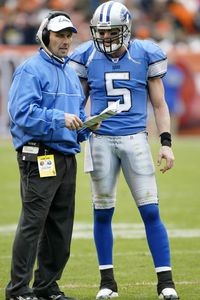
The Lions under Mooch employed a WCO that has had a significant bearing on Olson as an OC, however, it became clear that Olson employed more of a vertical passing scheme. While Olson never actually coached with Mike Martz, the offensive guru who replaced him as offensive coordinator the following season, Greg was known to have studied Mike’s rather complex vertical passing offense that led to “the Greatest Show on Turf.” Martz’ offense was predicated on timing and accuracy by his QB and WR, two attributes that Bortles and his receivers possess.
In 2006 with the Lions starting over, it would seem the emphasis on the vertical pass caught the eye of the newly signed Rams Head Coach Scott Linehan who hired Olson as his OC. The Rams finished sixth in yards in 2006 as Marc Bulger had his best season as a pro starting every game while backups Gus Frerotte and Ryan Fitzpatrick, in his second NFL season, warmed the bench. For the season Bulger completed an impressive 63 percent of his passes for over 4,300 yards along with 24 TDs and 8 INTs. Linehan started out the season calling the plays, however, after ten games with the team 4-6 after reeling off five straight losses, he handed the play calling duties over to Greg Olsen citing lack of production. With Greg calling the plays, the Rams finished 4-2 as Bulger had three games with over 300 yards including a 4 TD win where he had a 10.2 YPA and a 134.5 QB rating.
Olsen continued calling the plays to start out the 2007 season, but after a 0-5 start, Greg was sent upstairs to the coach’s booth with Linehan taking back over as the Ram’s play caller. Of note, in a week two loss to the 49ers, Bulger threw for 368 yards with a 9.0 YPA and a 96.4 QB rating. The offense never did take off that season ultimately ranking near the bottom as the team finished 3-13. Marc started twelve games that season with Gus Frerotte starting three, with rookie Brock Berlin starting one, and with backup Todd Bouman not seeing a snap. Olsen was among several staff members fired that offseason.
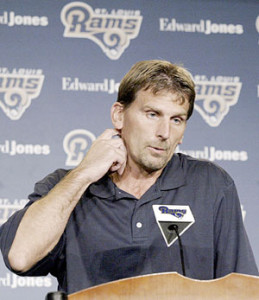
Oley found himself re-united as Jeff Garcia’s QB coach once again in 2008 with the Bucs as his former pupil would split starts with former Broncos QB Brian Griese. Both quarterbacks were in their final full season as a pro with Griese retiring the following offseason and Garcia hanging around a couple more seasons without throwing a single pass. The roster also consisted of two backups: Luke McCown who would be on the Jaguars roster the following year, and Josh Johnson who never played as a rookie. The team had a promising season in the works with Jeff Garcia at one point going 6-1 in the W-L column, but a December losing streak prompted the Bucs to fire head coach Jon Gruden and GM Bruce Allen. Griese struggled in his five starts, but Garcia had a solid season starting 11 games with a 90.2 QB rating, including 5 games with a passer rating over 100 and a YPA over 8.4.
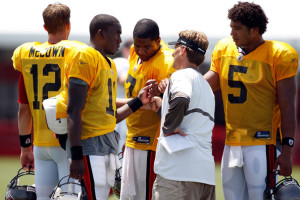
Under new head coach Raheem Morris and new GM Mark Dominik in 2009, Greg Olsen was promoted from Quarterbacks Coach to Offensive Coordinator replacing incumbent Jeff Jagodzinski ten days before the start of the regular season. The quarterback position featured Dominik’s first round pick Josh Freeman who wound up starting the final nine games of the season with a 3-6 record, along with Byron Leftwich who started the season 0-3, and Josh Johnson who went 0-4 after that. This was a tough building season for the new regime in Tampa Bay, however, they ended the season with their arrow pointed up going 2-1 in their last three games including a road win over the eventual Super Bowl Champion New Orleans Saints. One bright spot for the offense was their newly acquired TE from the Browns, Kellen Winslow. The incredibly athletic TE produced over 65 receptions in all three of Olson’s seasons as Offensive Coordinator for the Bucs (’09, ’10 and ’11) along with posting 8 games with over 80 receiving yards.
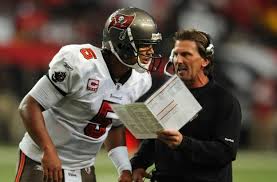
In 2010 under Oley’s guidance with the youngest roster in the league beginning to take shape, the Bucs offense nearly carried the team into the Playoffs. The Bucs finished 10-6 with Josh Freeman scoring 25 TDs to only 6 INTs as his 95.9 QB rating set the Bucs record for a 16-game starter. In half his games Freeman finished with a qb rating over 95, and in half of those over 120. He was so impressive over the final four weeks of the season that his combined stat line speaks for itself:
4 starts (3 wins, 1 loss), 77 of 109 (70.6%) for 1009 yards (9.3 YPA), 9 TDs and 0 INTs for a 127.0 qb rating.
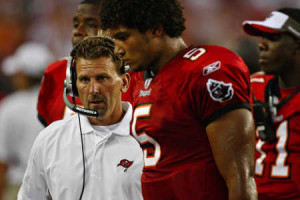
Among these games was a 38-15 win over the Seahawks that saw Freeman post an 80.8 completion percentage, 5 TDs and a near perfect 144.2 QB rating. Freeman quickly established a lethal connection with rookie fourth-round pick Mike Williams who, in part due to his uncanny jump ball elevation, finished the season leading all rookie receivers in yardage (964), receptions (65) and TDs (10) while setting most of the Buc’s rookie WR records and landing on a couple All-Rookie teams. The passing game worked in part as it fed off their power running game thanks to undrafted rookie LaGarrette Blount who became the second undrafted RB in league history to gain over 1000 yards, and in part due to another rock solid season from TE Kellen Winslow. Even backup QB Josh Johnson had a solid season completing 14 of 16 passes for 111 yards and a 95.6 QB rating.
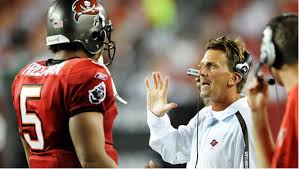
Depending on the situation, the Bucs were known to employ both gap and zone blocking techniques, and Olson has already indicated to the Jacksonville media that may do the same here. In 2010, Olson managed to get a power run game going allowing for some deep play action opportunities, but that run game fizzled out in 2011 forcing him to revert more to West Coast passing tactics to move the ball. In 2011 Josh Freeman threw for even more yards with a higher completion percentage than he had the year before, however, several of those TDs from the previous season turned into INTs and lost fumbles as the offense basically fell off its track. An offensive inability to score first quarter TDs for much of the season, along with a myriad of first quarter defensive let downs, added to Oley’s struggles as the team consistently fell behind early forcing him to abandon the run. With the defense ranking at or near the bottom of the league in most categories, the Bucs ultimately finished the season 4-12 with Raheem Morris, Olson and the entire coaching staff getting their walking papers.
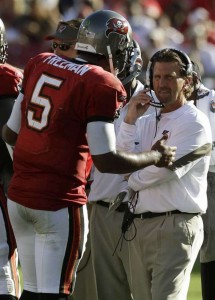
With Shad Khan taking over as the Jaguars owner in 2012 and hiring Mike Mularkey as the team’s new Head Coach, Oley found himself back in his familiar Quarterbacks Coach position, although this time the position carried the sub-title “Assistant Head Coach.” Olson would face his biggest challenge in terms of quarterback preparation with the Jaguars 2011 first round pick Blain Gabbert vying with Chad Henne for playing time as Jordan Palmer occasionally joined them in the Quarterback’s room. Gabbert was an intelligent, strong-armed quarterback with a quick release, but his footwork was atrocious, he was afraid to get hit, and he never quite developed a feel for the pocket nor an ability to see downfield leading to all sorts of issues. That said, Gabbert improved on his rookie season in a most areas under Olson’s tutelage. Blaine’s sacks, INTs and fumbles per game dropped while his completion percentage, YPA and QB rating improved as he found a reliable connection with Cecil Shorts. In a game against the Raiders, Gabbert looked he was in a zone, even nailing a few deep strikes, as he posted a 123.8 QB rating before leaving due to injury allowing an ill-prepared backup Chad Henne to lose an otherwise sure win. Henne took over after just a few passes into a game against the Texans and had a blockbuster outing with a season-high 126.8 QB rating as rookie Justin Blackmon broke loose.
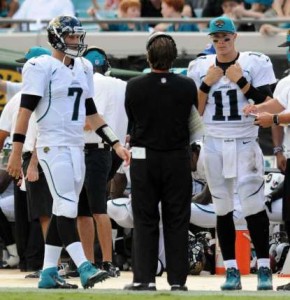
In 2013 the Raiders decided to move on from Carson Palmer, in part with an eye toward their future at the position, and opted to hire Greg Olson as their Offensive Coordinator. Early on Raiders offensive players were gushing about Oley citing the creativity with his playbook, his expectations for players to improvise and make plays when the situation changes, and how his play-calling gives them a chance to win games.
The Raiders initial plan after trading Palmer to the Cards was to go with Matt Flynn out of the gate while drafting Tyler Wilson in round four and picking up Matt McGloin as an undrafted rookie. Terrelle Pryor, drafted by the Raiders in round three of the 2011 Supplemental Draft, managed to beat out both Flynn and Wilson to start the 2013 season, and on opening day he set the Raiders rushing record for a qb with 13 carries for 112 yards. Pryor was strong out of the gate, and by week five had amassed some an impressive stat line (Matt Flynn started week four as Pryor sat the game out with a concussion):
4 starts (2 wins, 2 losses): 71 of 104 (68.3%) for 845 yards (8.1 YPA), 4 TDs and 2 INTs for a 97.6 QB rating. 37 carries for 229 yards (6.2 ypc)
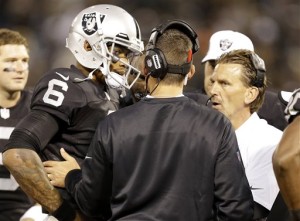
Pryor’s production slacked off a bit after that, likely as teams gathered tape on him, as he threw 1 TD to 8 INTs over the next four games. By the conclusion of week nine having amassed a 3-5 record, he found himself nursing an MCL sprain and subsequently benched in favor of Matt McGloin. Olson talked about how he needed to suit the offense to fit the less mobile McGloin while maintaining a level of consistency overall. Statistically McGloin looked solid week-to-week prompting some to think he may be their quarterback of the future, however, he ended his season with a paltry 1-5 mark as a starter. Olson mentioned how both Pryor and McGloin have development potential but how neither is a “certain number one.”
To kick off 2014 the Raiders turned to the draft where they picked up Derek Carr in round two along with taking a flyer on free agent Matt Schaub who they expected to start the season. During the Preseason Carr managed to beat out both Schaub and McGloin for the start, and he continued to start every game of a tumultuous season. The Raiders lost their first 10 games but seemed to turn a corner around their bye week as Carr started putting up some impressive numbers. In a week six loss in San Diego, Derek put up 4 TDs to 1 INT with a 8.3 YPA and a 107.7 QB rating. e followed that game up with a gritty performance against the Cards staunch defense before posting a 328-yard game with a 86.0 QB rating in Cleveland. His numbers tapered off a tad since, but down the stretch the Raiders won three of their last six games.
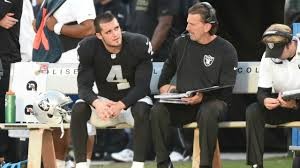
One gripe I noticed among fans both in Tampa Bay when the team struggled and in Oakland was a tendency to force players into his scheme. Now Olson openly talks about shaping this scheme around players, but the evidence suggests there are at least a few roles he intends to employ whether or not talent exists on the roster to employ them. In particular is his longing for a power running game up the middle. In Oakland they picked up Jones-Drew for this purpose, but for whatever reason he never did get going like the player he was in Jacksonville. Fortunately for the Jaguars they have a power RB in Toby Gerhart who appears perfect for Oley’s scheme. Should Toby meet Olson’s expectations as an up-the-gut runner, Bortles should be able to employ some deeper play action passes.
It’s when Olson fails to establish a running game that he resorts to WCO tactics and his offense starts to look more dink-and-dunk. The Raiders offense under Olson last year ranked among the worst in league history, and that’s understandably a discouraging thought for Jaguars fans. Their running game in particular was appalling as it ranked dead last in the league by a long shot. The early talk of Olson’s creativity turned to talk of a conservative, vanilla offense that never tried anything tricky. Still, the Raiders brass seem to have their own perspective on the man as they nearly hired him to take over as Interim Head Coach when they parted ways with Dennis Allen, although they ultimately chose Tony Sparano instead.

